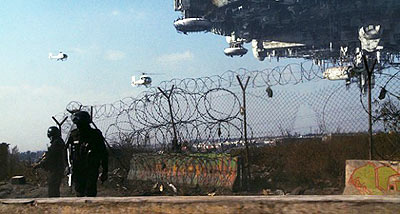District 9
Published on September 29th, 2009 in: Action Movies, Current Faves, Halloween, Horror, Issues, Movie Reviews, Movies, Reviews, Science Fiction |By Michelle Patterson
A car windshield splattered and smeared with the guts of bugs and men and swirls of dust and haze appears in front of the camera, doubling as a means to lessen the intense sun of South Africa. The bloody spray of horror married with the vroom-vroom of the action film—all in the midst of a bleak near-future within the science-fiction genre. It adds to the grime of this particular dystopia.

The urge to lean forward and wipe the screen clean underlines the danger of peeling paint and rusting barbwire prison. Rather than merely stylized grittiness, there is a deep connection between the locale and the action because it feels much closer to a potential reality as opposed to a stylized one. It helps the escalation of terror but never overwhelms the characters on the screen, as some science fiction tends to do. District 9 marks the arrival of an interesting new cinematic talent in director Neill Blomkamp. But take a shower, afterwards. You’ll feel better.
Like many action movies, the violence in District 9 is linked to first-person shooter videogames via a sense of glee and mischief. There is no link to reality; it is merely there for us to giggle when various characters turn into exploding, pink Spam meat (which isn’t to say that it isn’t disgusting through and through). We’re talking gooey aliens and the long and agonizingly slow metamorphosis of a man into a revolting creature. Much like David Cronenberg’s The Fly, the transformation from human to an unrecognizable creature is a long and exceedingly gross process, but you can’t look away from the screen. This is not an antiseptic vision of a clean slate future. Instead, it’s served up as an ugly, brutal, and filthy dish. Yet, it doesn’t feel gratuitous or unnecessary.
Unfortunately, the allegory of this film never sticks to one idea; it leaves too much room for interpretation and a tendency to smear the message onto another and then onto another, depending on the scenario. This all lessens the implications of immediate action, and stops the momentum dead in its tracks. Bad things are happening and will continue to, but does it really matter? Are we bemoaning the horrifying aspects of apartheid developing into full-blown genocide or the results of the corporate blackhearts’ capitalistic obsessions?
A literal politic hodgepodge, it becomes more and more difficult to figure out if this is an allegory about Darfur or a callback to the blistering history of South African apartheid or the continuing frustration of the refugee movement during Hurricane Katrina. This film’s canvas has already been painted in shades of grey and brown; placing black and white situations and characters into it makes it that much more difficult to get to the heart of the matter. Just because the film looks messy doesn’t mean the message has to be difficult to understand. The simpler the theme, the more it feels as though it could really happen.
Pages: 1 2
Time limit is exhausted. Please reload the CAPTCHA.